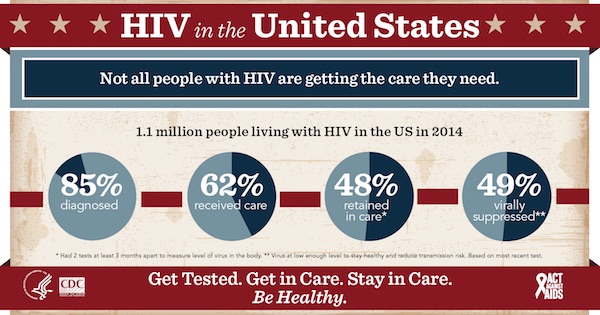HOUSTON—When it comes to taking pills, less is more, as researchers at the Michael E. DeBakey VAMC found when they compared a single tablet therapy for human immunodeficiency virus to a once-a-day multipill regimen.
Patients taking a single tablet to control HIV had better viral suppression and stayed in care at higher rates than patients who took multiple pills, according to a study published in AIDS Care.1

“This was a surprising finding to me,” said Thomas P. Giordano, MD, MPH, a researcher at the DeBakey VAMC, assistant professor in the division of infectious diseases at Baylor College of Medicine and medical director of the Thomas Street Health Center in Houston.
While the difference could be that the single tablet is more efficacious, large randomized trials have found the two therapies to be equivalent in terms of viral suppression rates, Giordano told U.S. Medicine.
The difference might be related to how providers choose patients for each regimen. “The protease inhibitor regimen is considered to be more forgiving to missed doses (meaning the HIV is less likely to get resistant to the medication, even in the face of some missed doses) compared to the [non-nucleoside reverse transcriptase inhibitor] regimen, and so the protease inhibitor regimen is probably more likely to be prescribed to persons with known barriers to adherence and retention in care,” he said. Barriers to care for the population in the study included mental health issues, substance use and socioeconomic challenges, among others.
To minimize potential confounding, both regimens were tenofovir based. The multitablet regimen included a protease inhibitor in addition to either ritonavir-boosted atazanavir (65%) or darunavir (35%). The single-tablet regimen was efavirenz-based.
The study represents the first direct comparison of once-a-day single tablet and multiple tablet regimens in a clinical setting. It also is the first to conducted in a racially and ethnically diverse population with significant barriers to adherence and retention.
The results could affect treatment choices at the VA, which provided HIV care for more than 28,000 veterans in 2016. Many of the multipill regimens are becoming available as generics, with lower associated costs. Greater disease control also is associated with lower costs, however.
While “veterans have many challenges to adherence and retention,” Giordano noted, “the VA also provides easier access to pharmacy refills with mailouts and 90-day supplies, which may not have been available to all the nonveteran patients in this study.”
The retrospective study analyzed adherence, retention and viral suppression for 622 patients who started single tablet therapy and 406 who began multitablet therapy between Jan. 1, 2008, and Dec. 31, 2011. All patients received care through the Thomas Street Health Center, a free-standing HIV clinic that operates as part of the county-run Harris Health System in Houston.
The researchers defined adherence as medication coverage for at least 80% of the year, based on prescription fills. Both treatment options had similar rates of adherence, 33% for the single-tablet group and 30.1% of those taking multiple tablets. The researchers determined that an additional 13.3% of multiple-tablet patients and 15.8% obtained medications elsewhere, based on laboratory results indicating viral suppression despite no record of prescription fills.
The similar levels of adherence between the two regimens did not surprise Giordano, based on previous research. “With a higher number of pills, adherence may falter. But, it seems for many patients, taking one pill a day is not that different than taking two or three pills at the same time once a day,” he said.

Once-Daily Pill a Major Change
The once-daily regimen, whether of one or a small number of pills, represents a major change from the early days of antiretroviral therapy, which required taking a dozen or more pills at several points throughout the day.
Retention was indicated by two viral load measurements within the 12 months after beginning ART, with the measurements separated by at least three months. The researchers found that 80.7% of patients on the single-tablet therapy remained in care compared to 72.7% of those on the multitablet therapy.
Still, a “retention in care rate of 70%-80% is good,” Giordano noted.
Viral load of less than 400 copies/mL indicated suppression in 2008. The researchers used a threshold of viral loads below 50 copies/mL to define suppression in later years. Virologic suppression at any point in the first year of therapy occurred in 84.4% of patients on single-tablet therapy and 77.6% of those taking a multitablet regimen.
Looking at only those patients who remained on the therapy initially prescribed attenuated the difference somewhat, with 79.4% of patients in the single-tablet group and 72.9% of those in the multitablet group achieving suppression. In the first year of therapy, 13.1% of multitablet patients and 15.6% of single tablet patients switched regimens, although the researchers found no significant differences in the proportion of those who had virologic suppression or the time between initial prescription and a change in medication among the patients who switched.
The two groups had some significant differences in their baseline demographics, which the researchers attempted to balance via a propensity score model. Patients who received single-tablet therapy were more likely to be male, as efavirenz is teratogenic and less likely to be prescribed to women of childbearing age. A sensitivity analysis found little change in the results, however, when the analyses were run separately for men and women.
“On balance, I think the results support a single-tablet regimen when possible,” Giordano said, “but using a contemporary once-daily multitablet regimen should not be abandoned, if that is judged to be a better regimen for the patient based on factors like comorbidities, drug-drug interactions, side effects and prior resistance.”
1. Hemmige V, Flash CA, Carter J, Giordano TP, Zerai T. Single tablet HIV regimens facilitate virologic suppression and retention in care among treatment naïve patients. AIDS Care. 2018 Aug;30(8):1017-1024.

